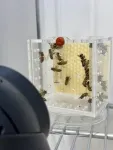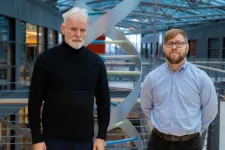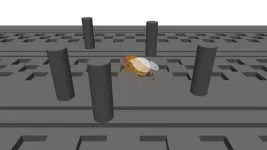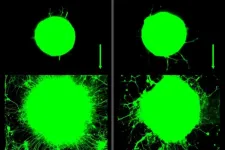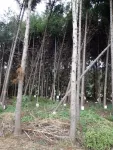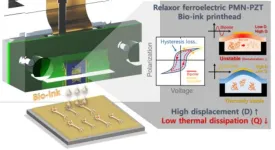(Press-News.org) In an emerging red flag for the digital era, sleep experts have warned us to avoid screen time in bed, sounding the alarm that light emitted from phones and other electronic devices can disrupt our sleep patterns. That’s one way that science is waking up to the broad range of health and disease implications related to circadian biology and our daily sleep-wake cycles.
Now, researchers at the University of California San Diego have found that light disruption is not only a health concern for humans. A new study led by PhD candidate Ashley Kim and Professor James Nieh in the School of Biological Sciences has found that artificial light disrupts the circadian rhythms of honey bees and poses a threat to their essential role as pollinators.
“Our research shows just how sensitive honey bees are to changes in their environment, particularly to something as seemingly benign as artificial light,” said Kim of the study, published in Scientific Reports. “By disrupting their circadian rhythms, we see clear evidence of reduced sleep periods. This raises significant concerns, not only for bee health but also for the health of ecosystems that depend on them for pollination.”
Honey bees play a crucial role as pollinators of wild plants and important crops, providing services that support ecosystem stability and global food security. Without pollination, crops worth tens of millions of dollars would be at risk.
Honey bees generally prefer to nest in dark environments, although a small amount of light can enter from the hive entrance. Sleeping bees typically remain immobile but exhibit subtle movements if disturbed by nestmates. However, bees sleep outside when they swarm or when they form “bee beards” outside the nest on hot evenings, which are increasing under climate change. While the prevalence of artificial light at night (ALAN), or light pollution, on sleeping honey bees varies from region to region, modern urban environments are increasingly exposed to artificial light conditions, especially as temperatures rise. Because there has been a resurgence of urban beekeeping in many areas to support bees and their critical pollination services, bees that experience hotter weather are now potentially more exposed to ALAN.
Like us, when bees experience a poor night’s sleep and disrupted circadian patterns, problems in behavior and function emerge. Sleep is crucial for the health and fitness of honey bee colonies since they depend on an intricate system of communication known as the “waggle dance” that informs hive mates about the location of food sources in the environment. Bees dance more poorly and therefore do not communicate as well if they do not get enough sleep.
Through a series of experiments spanning several years, the UC San Diego researchers compared groups of bees that underwent normal sleep in the dark with others that were subjected to continuous artificial light. The results clearly showed that prolonged exposure to light significantly disrupted the circadian rhythms of honey bees, leading to impaired behaviors. Since the bees were video recorded 24 hours a day during the experiments, Kim could immediately see the effects of disrupted sleep.
“Even without analyzing the data you can tell that there was something going on… the bees that were under constant light slept less,” said Kim. “The effects of light pollution on biological systems is fairly unknown and something people normally don’t think about, which is why it’s a rapidly evolving field.”
Among the details described in the paper: Bees exposed to continuous light slept less and were more frequently disturbed by their peers compared to those kept in normal darkness. Also, bees under continuous light exhibited a preference for darker areas within their experimental cages.
“Understanding the factors that affect bee health, such as light pollution, is essential for developing strategies to protect pollinator populations,” said Nieh. “Light pollution is a growing issue, with artificial light now covering a quarter of the Earth’s surface, and this research sheds new light on how such disturbances may be harming pollinators.”
Two coauthors of the study, Aura Velazquez (Universidad La Salle México) and Belen Saavedra (Berea College), are undergraduate students who participated in the research as part of UC San Diego’s ENLACE initiative, a binational summer program in which students conduct research during a seven-week project.
“I am pleased that the ENLACE summer research program was pivotal in providing research experiences for the student authors of this study,” said Olivia Graeve, the director of the ENLACE Program at UC San Diego and a professor in the Department of Mechanical and Aerospace Engineering, Jacobs School of Engineering. “By fostering collaboration between students from Latin America and the United States, we help young researchers gain valuable hands-on experience, building skills and friendships that extend across borders. This project exemplifies the impact of ENLACE, as it brings together diverse perspectives to address global challenges like pollinator health and environmental sustainability.”
Nieh and study coauthor Benjamin Smarr, a faculty member in the Shu Chien-Gene Lay Department of Bioengineering, Jacobs School of Engineering, and Halıcıoğlu Data Science Institute, were recently awarded a related grant — which extends to human impacts — from the new Chancellor’s Interdisciplinary Team Catalyst Fund. “Harmonizing the Pulse of Life: Pioneering Circadian Insights for Human and Ecosystem Health at UC San Diego” furthers research on circadian biology and ecosystem health. The Nieh and Smarr labs will collaborate to examine circadian rhythms across scales, from individual bees to entire ecosystems.
“The Catalyst Grant allows us to connect research on honey bee circadian rhythms to larger questions about biological synchronization across ecosystems and human health,” said Nieh. “This program fosters interdisciplinary collaboration, bringing together experts in biology, data science and medicine to address pressing issues like light pollution and its impact on pollinator health. Our work with the Catalyst Grant strengthens UC San Diego’s role in advancing solutions for both environmental sustainability and human well-being.”
END
Sleep is no light matter for bees
Artificial light found to disrupt the circadian cycle of vital ecosystem and economic pollinators
2024-11-12
ELSE PRESS RELEASES FROM THIS DATE:
New study explores the role of BMI in disease risk
2024-11-12
New study from deCODE genetics/Amgen highlights the importance of BMI in pathogenesis of disease, suggesting that reducing BMI alone could lower the risk of several diseases.
Scientists at deCODE genetics, subsidiary of Amgen, published a study today in Nature Communications that sheds light on how Body Mass Index (BMI) influences the risk of various diseases that are comorbid with obesity. The study, which used genetic data from Iceland and the UK Biobank, looked at whether disease risk associated with BMI-related sequence variants are explained completely or partially by their effect on BMI.
The results showed that for some conditions, such as fatty liver disease, glucose intolerance, ...
Guardian, kids, or companions? What do dogs mean to us today
2024-11-12
What role do dogs play in today’s world? For many, they are more than just pets. New findings from the Department of Ethology at Eötvös Loránd University show that whether seen as friends, family members, children or guardians, these roles affect the way dogs are cared for, suggesting shifting dynamics in human-animal bonds shaped by societal trends and individual owner profiles.
In Western cultures, more and more people see their dogs as their best friends, family members or even their furry children. In fact, ...
NeuroMechFly v2: Simulating how fruit flies see, smell, and navigate
2024-11-12
All animals, large or small, have to move at an incredible precision to interact with the world. Understanding how the brain controls movement is a fundamental question in neuroscience. For larger animals, this is challenging because of the complexity of their brains and nervous systems. But the fruit fly, Drosophila melanogaster, has a smaller and therefore more easily mappable brain, allowing scientists to gain detailed insights into how its nervous system drives behavior.
To understand how the nervous system controls actions, researchers at the group of Pavan Ramdya at EPFL created a simulated reality where a virtual fly can operate ...
“Drowning” mangrove forests in Maldives signal global coastal threat
2024-11-12
Researchers have found evidence that mangrove forests – which protect tropical and subtropical coastlines – are drowning in the Maldives.
Their findings, published today (Tuesday 12 December) in Scientific Reports, indicate that rising sea level and a climate phenomenon known as the Indian Ocean Dipole have led to some Maldivian islands losing over half of their mangrove cover since 2020.
The research team, led by Northumbria University, warn that the findings have implications not only for the Maldives, but also for other island nations and coastal ecosystems around the world.
In 2020, more than a quarter of the Maldivian islands containing mangrove forests saw their trees experiencing ...
When muscles work out, they help neurons to grow, a new study shows
2024-11-12
There’s no doubt that exercise does a body good. Regular activity not only strengthens muscles but can bolster our bones, blood vessels, and immune system.
Now, MIT engineers have found that exercise can also have benefits at the level of individual neurons. They observed that when muscles contract during exercise, they release a soup of biochemical signals called myokines. In the presence of these muscle-generated signals, neurons grew four times farther compared to neurons that were not exposed to myokines. These cellular-level experiments suggest that exercise can have a significant biochemical effect on nerve growth.
Surprisingly, the researchers also ...
Smokers who switch to vaping see improved respiratory health
2024-11-12
A new paper in Nicotine and Tobacco Research, published by Oxford University Press, finds that people who switch from smoking cigarettes to vaping see improved respiratory health, but people who begin consuming electronic cigarettes while continuing to smoke regular cigarettes do not report improved respiratory symptoms.
Adults increasingly use electronic cigarettes to try to quit smoking because of the perceived reduced risk. But while vaping reduces exposure to toxic chemicals, it has been unclear whether switching from cigarettes to e-cigarettes results in a reduction of the respiratory problems—like wheezing and coughing—common in regular cigarette ...
Air pollution emerges as critical environmental risk factor for autism, emerging topic review finds
2024-11-12
Boston, Massachusetts, 12 November 2024 – Environmental exposure to air pollutants during critical developmental periods may significantly impact autism risk, according to a groundbreaking Emerging Topic review published 12 November 2024, in Brain Medicine. The study reveals how common air pollutants, including fine particulate matter and nitrogen oxides, can trigger complex biological cascades affecting brain development.
"Different kinds of neurological disorders, including autism spectrum disorder, can be associated ...
Autism and nitric oxide: Professor Haitham Amal unveils brain disorder breakthrough
2024-11-12
Boston, Massachusetts, 12 November 2024 – The complex interplay between nitric oxide and brain disorders takes center stage in the latest Genomic Press Interview, published November 12, 2024, in Brain Medicine. Professor Haitham Amal, head of the Laboratory of Neuromics, Cell Signaling, and Translational Medicine at the Hebrew University of Jerusalem, shares insights into his groundbreaking research and personal motivation.
“Meeting families and children with autism in Boston during my time at MIT inspired me to focus on a single goal: to help develop biological diagnostics ...
Facing the wind: How trees behave across various forest settings and weather events
2024-11-12
Destructive winds during storms and cyclones often cause tree failures, especially through uprooting and stem breakage. However, how trees respond to wind under various forest configurations and weather conditions remains unclear. A recent study on Cryptomeria japonica plots shows that trees dissipate wind energy by switching between two swaying behaviors at specific wind speeds, offering insights that may help in improved forest management to minimize damage caused by storms.
Extreme weather events, such as tropical and extratropical cyclones and tornadoes, can cause widespread damage to forests, leading to environmental and financial ...
High-performance inkjet print head enhances bioprinting productivity
2024-11-12
Bioprinting is a technology used to create three-dimensional structures, such as human tissues or organs, using bio-inks made of cells and hydrogels. However, conventional inkjet technology has difficulty dispensing bio-inks that are sensitive to temperature due to the heat generated during operation. Furthermore, conventional 3D bioprinting mainly utilizes simple syringe-type printing devices with a single needle, making it time-consuming to produce artificial organs like the brain, lungs, and heart.
The Bionics Research Center team, led by Dr. Byung Chul Lee at the Korea Institute of Science and Technology (KIST, President Sang-Rok Oh), in ...
LAST 30 PRESS RELEASES:
New expert guidance urges caution before surgery for patients with treatment-resistant constipation
Solar hydrogen can now be produced efficiently without the scarce metal platinum
Sleeping in on weekends may help boost teens’ mental health
Study: Teens use cellphones for an hour a day at school
After more than two years of war, Palestinian children are hungry, denied education and “like the living dead”
The untold story of life with Prader-Willi syndrome - according to the siblings who live it
How the parasite that ‘gave up sex’ found more hosts – and why its victory won’t last
When is it time to jump? The boiling frog problem of AI use in physics education
Twitter data reveals partisan divide in understanding why pollen season's getting worse
AI is quick but risky for updating old software
Revolutionizing biosecurity: new multi-omics framework to transform invasive species management
From ancient herb to modern medicine: new review unveils the multi-targeted healing potential of Borago officinalis
Building a global scientific community: Biological Diversity Journal announces dual recruitment of Editorial Board and Youth Editorial Board members
Microbes that break down antibiotics help protect ecosystems under drug pollution
Smart biochar that remembers pollutants offers a new way to clean water and recycle biomass
Rice genes matter more than domestication in shaping plant microbiomes
Ticking time bomb: Some farmers report as many as 70 tick encounters over a 6-month period
Turning garden and crop waste into plastics
Scientists discover ‘platypus galaxies’ in the early universe
Seeing thyroid cancer in a new light: when AI meets label-free imaging in the operating room
Neutrophil-to-lymphocyte ratio may aid risk stratification in depressive disorder
2026 Seismological Society of America Annual Meeting
AI-powered ECG analysis offers promising path for early detection of chronic obstructive pulmonary disease, says Mount Sinai researchers
GIMM uncovers flaws in lab-grown heart cells and paves the way for improved treatments
Cracking the evolutionary code of sleep
Medications could help the aging brain cope with surgery, memory impairment
Back pain linked to worse sleep years later in men over 65, according to study
CDC urges ‘shared decision-making’ on some childhood vaccines; many unclear about what that means
New research finds that an ‘equal treatment’ approach to economic opportunity advertising can backfire
Researchers create shape-shifting, self-navigating microparticles
[Press-News.org] Sleep is no light matter for beesArtificial light found to disrupt the circadian cycle of vital ecosystem and economic pollinators


